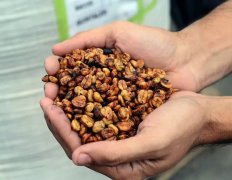Costa Rican yellow honey leaves Salocadura fine coffee beans hand brewing parameters recommendations

Professional barista communication, please pay attention to coffee workshop (Weixin Official Accounts cafe_style )
Hand-washed yellow honey. 15g powder, medium grinding (small Fuji ghost tooth knife 4 grinding), v60 filter cup, 88-89 degrees water temperature, the first injection of 30g water volume, 27 seconds of stewing, injection to 105g water volume cut off water, wait for the powder bed water volume to drop to half, then inject water slowly until 225g water volume, tail section do not, water powder ratio 1:15, extraction time 2:00
Factory Name: Dazhen Coffee Front Street Cafe Address: No. 10 Baoan Front Street, Guangzhou City Factory Contact: 020-38364473 Ingredients List: Self-baked Shelf Life: 90 Net Content: 227g Packaging: Bulk Coffee Bean Ripe Degree: Coffee Ripe Bean Sugar: Sugar Free Origin: Costa Rica Coffee Type: Other Roasting Degree: Moderate Roasting
Costa Rica Helsar De Zarcero
Country: Costa Rica Fiscal year: 2003
Grade: SHB
Location: West Valley
Degree of roasting: medium roasting
Processing method: yellow honey
Yellow honey treatment method: about 40% of pectin is removed; drying method needs the most direct heat absorption, accept the most light drying, lasting about 8 days to reach the stable value of moisture content.
Costa Rican coffee has always been regarded as the perfect type of classic flavor, balanced, clean, mild is his tone, this batch of western valley producing area Yelsalo processing plant, known for excellent natural geographical conditions and excellent regional planting management technology, almost perfect classic flavor, on the sour feel with lively citrus flavor, blackberry fruit aroma, acid and taste thick, melon sweet taste smooth, stone fruit/slightly floral, and the finish has a significant coffee flower aroma, It's a Latin country coffee.
Varieties: Kadura, Kaduai
Treatment Plant: Yelsalo Treatment Plant
Flavor: Brown sugar, almond, black tea
Costa Rica is the first country to introduce coffee into Central America. It has a long history and a complete coffee organization system from production to sales. Because it is located in the Central American Isthmus, there are many volcanoes in the territory, it has the natural advantages of sunshine and land, and the climate is simultaneously reconciled by the Pacific Ocean and Atlantic Ocean currents and sea breezes. The coffee produced has the characteristics of local micro-climate and terroir conditions. In terms of quality and quantity, Costa Rica's coffee has always been recognized by the world and has been rated as one of the world's high-quality coffees.
Fertile volcanic ash, mild temperatures, and steady rainfall are among the factors that have made coffee a major agricultural product in Colombia. The seven regions are Tarrzu, Tres Rios, Orosi, Central Valley, West Valley, Turrialba and Brunca.
Costa Rica has a long history of coffee cultivation, but in the past 10 years, more advanced "dry" treatment method has become a trend, collectively referred to as "honey treatment" new method, the use of scraper to adjust the degree of pulp scraping function, the output with the color from light to dark (white, yellow red, yellow red) and present "honey feeling" from light to thick, acidity, complex aroma thick feeling…each has depth, each has its own merits. Herbazu processing plant is located in the West Valley region of Orange County (Naranjo) production area, because of the high reputation of this production area, in addition to its own coffee plantation, but also for nearby plantations and coffee smallholder service processing production beans.
Flavor: Brown sugar, floral, almond, black tea, orange and sweet spices, mild acidity, syrupy taste, good finish.
Important Notice :
前街咖啡 FrontStreet Coffee has moved to new addredd:
FrontStreet Coffee Address: 315,Donghua East Road,GuangZhou
Tel:020 38364473
- Prev

Stories and allusions of Cupid from Mount Baru in Panama containing 30% roses, summer beans, boutique coffee beans.
Professional baristas exchange please follow the coffee workshop (Wechat official account cafe_style) Panamanian coffee originated in 1780, by European immigrants to introduce the first Tipica tree species. Located in Central America, with the natural advantages of sunshine, land and mountains, coupled with a sufficient working population, the region is an excellent area for growing and producing high-quality boutique coffee.
- Next

Stories and allusions of Costa Rican Yelsa Rocadura boutique coffee beans
The exchange of professional baristas Please pay attention to the coffee workshop (Wechat official account cafe_style) the cultivation of coffee in Costa Rica has a long history, but in the past 10 years, even more cutting-edge dry treatment has become a trend, collectively known as the new method of honey treatment, the use of scraper to adjust the degree of scraping of the pulp function, the output with the color from light to dark (white, yellow-red-white, yellow-red-black) and show honey from light to
Related
- Detailed explanation of Jadeite planting Land in Panamanian Jadeite Manor introduction to the grading system of Jadeite competitive bidding, Red bid, Green bid and Rose Summer
- Story of Coffee planting in Brenka region of Costa Rica Stonehenge Manor anaerobic heavy honey treatment of flavor mouth
- What's on the barrel of Blue Mountain Coffee beans?
- Can American coffee also pull flowers? How to use hot American style to pull out a good-looking pattern?
- Can you make a cold extract with coffee beans? What is the right proportion for cold-extracted coffee formula?
- Indonesian PWN Gold Mandrine Coffee Origin Features Flavor How to Chong? Mandolin coffee is American.
- A brief introduction to the flavor characteristics of Brazilian yellow bourbon coffee beans
- What is the effect of different water quality on the flavor of cold-extracted coffee? What kind of water is best for brewing coffee?
- Why do you think of Rose Summer whenever you mention Panamanian coffee?
- Introduction to the characteristics of authentic blue mountain coffee bean producing areas? What is the CIB Coffee Authority in Jamaica?

